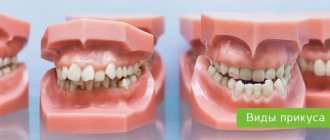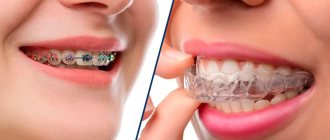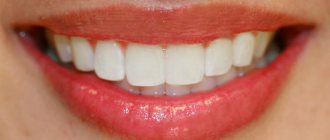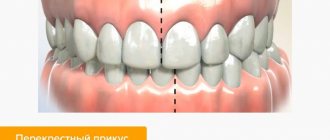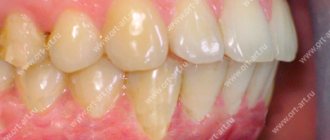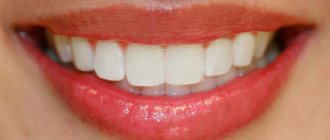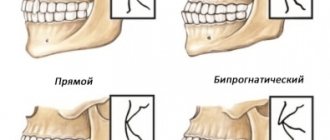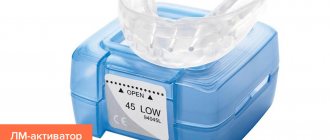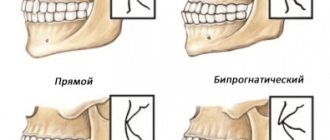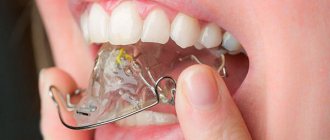53215
Crooked, unhealthy teeth can ruin the appearance of an otherwise attractive person. Oral health is important not only for our attractiveness, because the main function of teeth is to grind food. The condition of the stomach and intestines depends on this, which directly affects health and life expectancy .
Correct bite: what is it like?
Bite is the way the teeth of both jaws interact when they are completely closed. If it is correct, there are no difficulties when chewing and pronouncing sounds, the aesthetics of the smile is not impaired, but minor defects are still possible. What does a bite that does not require orthodontic treatment look like? Its main characteristics:
- Presence of 28–32 teeth. Not all people develop “eights”, which is determined by genetic factors. Their presence (if they have grown correctly) or absence does not affect the closure of the jaws. Moreover, in some cases, wisdom teeth removal is indicated during orthodontic treatment. Then there is more free space in the mouth.
- Symmetry in the closure of the dentition.
- The incisors of the upper jaw overlap the lower ones by one third.
- No interdental gaps, cracks or chips.
- Correspondence of molars and premolars of both dentitions to each other. Their closure is tight.
- Ease of chewing food, even hard ones. Opening the mouth is easy and there is no pain.
Correct bite does not always look aesthetically ideal. But the face is harmonious.
Everything you need to know about proper bite
Until now, we have talked a lot about malocclusion and ways to correct it. Today we propose to consider the situation from a slightly different point of view - how about studying exactly the correct bite? In this article we will answer pressing questions, and also tell you how to turn a correct bite into an incorrect one.
Why is correct bite important in Kirov?
First, let’s answer the primary question: why is it so important to have the correct bite? Indeed, according to statistics, about 90% of the world's population have a less than ideal bite, however, not everyone strives to correct this defect.
In fact, bite is not only a matter of aesthetics, but also an impact on the general condition of your body.
Everything is extremely simple: improperly closing jaws and distortions are, of course, an annoying defect, however, to a greater extent, malocclusions have an impact on your health. Let us name three reasons that come to the fore when considering this issue:
- Malocclusion is a disrupted process of chewing food, as a result of which food enters the gastrointestinal tract not completely crushed. This is what can cause diseases of the digestive system, not to mention bad breath, gas formation and other negative signs of malocclusion;
- Wear and tear of the jaw joint, which can very quickly become unusable due to improperly distributed load. Do you notice clicking sounds when chewing food? Can't open your mouth all the way from time to time? There is a high probability that you have problems with your bite - this is a reason to contact Kirov dentistry to get qualified advice from an orthodontist;
- Abrasion of teeth. Very often, people with malocclusion experience wear not only of the jaw joint, but also of the teeth themselves, which leads to their abrasion and loss of some volume. It is extremely difficult to treat such teeth; the end result can be a very disastrous outcome - tooth loss.
If you have a correct bite, these and many other problems will be unfamiliar to you. Otherwise, sooner or later all these signs will come to the fore.
And the most dangerous thing in this whole situation is lost time. It is more correct and easier to correct the bite at a young age, while it requires less time and effort. If you delay in making a decision, dangerous processes may begin in your body that are not directly related to the state of your smile.
What does a correct bite look like?
How can you determine that you have a correct bite without defects or anomalies? There are several signs:
- Harmonious oval of the face during closure (occlusion) of the jaw. To do this, just look at yourself in the mirror;
- Absolute symmetry of the lower part of the face (jaw). The opposite is quite indicative of existing problems;
- The midface should pass exactly between the first incisors of the upper and lower jaws;
- The location of the lower and upper teeth on the same line. It should be ensured that they are pressed tightly against each other without flaws;
- No crooked teeth;
- There are no gaps between teeth;
- In the natural position of the jaw, the upper teeth should overlap the lower teeth slightly (by about 1 or 2 millimeters).
You can carry out a similar diagnosis of correct bite in Kirov at home.
However, in order to definitely identify the presence of possible problems with occlusion, a consultation with an orthodontist is necessary, who will instantly determine the presence and extent of a possible problem. You can get this consultation in Kirov, for example, at Dr. Efremov’s Dentistry.
How to maintain the correct bite from a young age?
Very often, malocclusion occurs in the first years of life, but sometimes it is an acquired defect, which can be completely avoided. Below is a list of recommendations that will help you form and maintain a healthy bite to achieve a symmetrical smile for many years:
- The physiology of the masticatory apparatus is formed even before a person is born - it is important to ensure that the gestation period proceeds without complications and pathologies. In this case, there is a high probability that the child’s bite will be correct at birth;
- The process of breastfeeding is also an important factor influencing the formation of the bite. It is necessary to ensure that the baby takes the breast correctly and does not purse his lips during feeding;
- You should also not overuse a pacifier, otherwise there is a risk of disrupting the natural processes of formation of the masticatory apparatus;
- Bad habits in children (for example, thumb sucking or putting a toy in the mouth) also negatively affect the bite;
- Correct body position during sleep, which needs to be worked on from an early age. You should not allow resting with your mouth open, or with your head pressed or thrown back;
- Nutrition. After stopping breastfeeding, the child should receive a balanced diet, including solid foods to develop a milk bite;
- The need for timely treatment of diseases of the ears, nose and throat to avoid complications;
- Tuberculosis, rickets, dyspepsia, calcium deficiency - these diseases negatively affect the formation of a healthy bite;
- Monitoring the quality of oral hygiene, especially during the period of changing teeth in a child;
- The natural cycle of loss of baby teeth and appearance of permanent teeth is the key to the formation of a correct bite in Kirov. That is why do not forget to visit the dentist with your child every 6 months, even if it seems to you that all the teeth are fine;
- Correct seating at the table (especially during the training period). Scoliosis and other defects of the bone corset can lead to changes in the bite.
As we see, the formation of a bite is a matter of increased attention to the gestation, birth and maturation of a person.
However, some of these recommendations are also relevant for adult Kirov residents. For example, correct posture, oral hygiene, periodic professional examinations, etc. Even if you currently have a completely healthy bite, there is no guarantee that you will be able to maintain it for many years. Bad habits and other factors
may well bring all efforts to naught, and this requires much less time than it might seem at first glance.
Correction of bite in Kirov
We have spoken about this process several times and devoted entire articles to the problem. This time we will simply list the possible ways to correct a bite in Kirov:
- A visit to an orthodontist who will select the necessary treatment method;
- Installation of special structures in the oral cavity (braces, plates, transparent aligners, etc.);
- Surgical intervention (as a last resort) – removal of a tooth or several teeth;
How to correct a bite in Kirov? Only a qualified orthodontist can answer this question: sign up for a consultation at Dr. Efremov’s Dentistry and get answers to all your questions! Make an appointment by phone: 8 (8332) 255-717 . Be healthy and take care of the beauty of your smile!
Types of correct bite
The above describes the orthognathic bite, which is the reference. It occurs in only 5% of people. But there are other types of teeth closure in which violations are not detected. What does each one look like? Experts identify the following bites:
- Biprognathic. Both jaws are slightly pushed forward, and the teeth are slightly directed towards the lips.
- Opisthognathic. The opposite of the previous type. The teeth are directed inward. Opisthognathic occlusion is rare. Its features are noticeable when viewed in profile.
- Progenic. The lower jaw protrudes slightly, but this feature is not pathological. The functioning of the temporomandibular joint (TMJ) and the functionality of the teeth are not impaired.
- Straight. The upper row of teeth is parallel to the lower one. The incisors touch their cutting edges. This feature is not a deviation, but it threatens rapid wear of the teeth due to increased load.
Sometimes, if you have one of these malocclusions, minor adjustments may be needed. But the treatment in this case will be easy.
Bite in the absence of teeth
A person without teeth has problems with the functioning of the temporomandibular joints, facial aesthetics deteriorate, and wrinkles appear due to loss of skin tone. To avoid unpleasant consequences, it is necessary to restore the bite using a complete denture made using a special technique.
Bite restoration with complete dentures
- The central ratio of the jaws is determined - the position of the lower jaw in relation to the upper in three planes: vertical, sagittal and transversal. The role of the dentition is played by wax rollers.
- Measurements are taken using a device consisting of an external facebow-ruler and an intraoral plate with a flat frontal part and curved distal parts.
- The plaster model marks the boundaries of the future structure, the line of the middle of the alveolar process, the tubercles of the upper and lower jaw, and the midline.
- Artificial teeth are placed in such a way that when you smile, the part of the prosthesis that imitates the gum is not visible.
Anomalies in the closure of teeth
Dental rows are not always placed correctly. How do you know when treatment is required? Depending on the type of malocclusion, the following signs of violations are distinguished:
- Distal - the upper jaw is more developed when compared to the lower jaw. She comes forward significantly.
- Mesial. The situation is the opposite of the previous case - the lower jaw is more developed. It may bulge forward slightly or strongly.
- Cross. With this pathology, there are interdental gaps. Part of the upper front teeth is behind the lower ones, and the other part is in front of them. Such a smile looks unaesthetic. As a rule, teeth grow in different directions.
- Deep – the upper row of teeth almost completely overlaps the lower one. If even more than 30% of the teeth are blocked, this is considered a pathology. But visually such a violation may not be visible.
- Open. When the jaws close, only the chewing teeth come into contact; pronounced gaps are visible between the front teeth. In some cases, it looks like an open mouth.
Whatever the diagnosis, any pathology must be treated.
Transition from normal to anomaly
Over the years, physiological correct occlusion may undergo changes in a pathological direction. This is possible for a number of reasons:
- due to maxillofacial injuries;
- with the loss of part of the teeth and their prolonged absence;
- for gum diseases;
- if prosthetic work was performed untimely or incorrectly.
An ideal bite can suffer due to extreme stress. This phenomenon is usually accompanied by the tone of the masticatory muscles, increased tooth wear, and bruxism (grinding), which provokes displacement of the jaw bones.
How to find out what kind of bite you have
Patients are often interested in how to determine whether their bite is correct. Usually the presence of abnormalities can be identified by facial features. It is also worth taking into account the criteria for correct bite described above. Go to the mirror, open your mouth and clench your teeth. In some cases, violations are immediately visible. Just because your smile looks aesthetically pleasing does not guarantee that everything is fine.
Even if you know what a correct bite should look like, it is impossible to make a correct diagnosis on your own. Only a specialist can do this. In addition to a visual examination and medical history, the doctor diagnoses the problem based on the results of a CT scan (computed tomography). Such an examination allows you to comprehensively assess the condition of the oral cavity. Disturbances in the placement of teeth are also identified by an impression made from an alginate mass. The orthodontist also needs photographs of the person’s face taken from several angles. Using them, you can evaluate the occlusal relationships of the dentition.
What it is?
Occlusion in dentistry is usually called the localization of the lower and upper rows of teeth relative to each other. It can be either correct or abnormal. It is worth noting that the formation of a correct bite occurs in infancy.
Active development begins during the period of breastfeeding and continues until the complete replacement of milk teeth.
During adolescence, people already have a formed bite, which will remain unchanged throughout the rest of their lives.
But, it can change under the influence of the following factors:
- one or more teeth have fallen out;
- there was an injury to the jaws or face;
- severe gum disease has developed, etc.
Possible consequences of malocclusion
Anomalies in the location of the dentition relative to each other are fraught with the following problems:
- Increased stress on teeth, causing them to quickly wear out and break down. There is a risk of developing periodontal disease. If measures are not taken, a person may be left without teeth.
- Intensive formation of tartar. Sometimes bite pathologies do not allow you to properly brush your teeth.
- Increased gum sensitivity. Sometimes even ulcers form on them.
- Injury to the mucous membranes of the mouth, cheeks, gums, tongue, tissue inflammation.
- Development of TMJ diseases. They are provoked by increased load. These joints compensate for missing teeth. First, a person feels discomfort in the facial muscles, an unpleasant clicking in the TMJ, and pain appears. After some time, the headache begins to hurt, changes in appearance are visible.
- Malfunctions of the gastrointestinal tract. With malocclusion, it is difficult to chew food normally. Insufficiently crushed food ends up in the stomach, which leads to excessive stress on it. Over time, this can provoke some kind of disease.
- Disorders of respiratory, chewing and swallowing functions. If teeth are not positioned correctly, ENT diseases develop. Headaches and discomfort in the facial muscles appear.
In addition to problems with the health of the oral cavity and the body as a whole, malocclusion can provoke psychological problems. Because of an ugly smile, a person becomes insecure and complexes appear. Difficulties may arise with the pronunciation of sibilants.
Knowing how to determine whether your bite is correct, you can eliminate the problem in a timely manner before your health is damaged.
Why is correct bite important?
Correct occlusion is an important component of a person’s full life. With various types of curvature of the teeth, their disproportionate location, a person experiences psychological discomfort - difficulties arise in communication, a career does not work out, and so on. But with pathological occlusion, problems that lead to disruptions in the functioning of the entire organism become more significant.
- Jaws that do not close properly make it difficult to chew food. In this form, it is poorly processed, which provokes diseases of the digestive system.
- With abnormal occlusion, different jaws are affected unevenly. There is a high probability of abrasion, damage, and loss of teeth.
- Improper closing of the jaws creates a large load on the temporal joint, and the jaw muscles do not relax. This can cause regular headaches.
It happens that malocclusions cause displacement of the upper cervical vertebrae, cerebrovascular accidents, and narrowing of the airways, leading to respiratory arrest during sleep.
What causes malocclusion to form?
Defects appear for various reasons:
- Genetic predisposition. In most cases, mesial and distal bites are inherited. Therefore, parents who have this problem should take their child to an orthodontist in early childhood.
- Anomalies of fetal development. A child’s teeth are formed while still in the womb. During a complicated pregnancy or the influence of negative factors on its course, anomalies of the dental system can form.
- Birth injury. Mesial bite in some cases is a consequence of dislocation of the baby’s lower jaw during childbirth.
- Bad habits. Constant thumb or pacifier sucking, improper latching of the nipple, incorrect sucking during artificial feeding - all this provokes the development of malocclusion pathologies.
- Inferiority of the dentition. You can resort to removing baby teeth if there is less than a year left before the change. Otherwise, the dentition becomes asymmetrical, the midline shifts, and the chewing movements of the jaw are blocked. The formation of a permanent bite ends at approximately 15 years of age. For adults, after tooth loss, it is important to undergo prosthetics in a timely manner.
- Displacement of the jaws as a result of hypertonicity of the masticatory muscles, which can be observed due to stress.
Jaw injuries, as well as improper prosthetics, can provoke the development of malocclusions.
Formation of the correct bite
The bite is formed from birth, and the process lasts up to 15 years. Development occurs in stages, from the moment the first primary incisors appear. After changing all the elements, the bite becomes permanent. Its formation is directly influenced by both hereditary and external factors.
In childhood, it is important to pay increased attention to the prevention of the development of correct bite, so that the jaw bones and teeth alignment correspond to the physiological norm. For proper bite development it is necessary:
- Keep your baby breastfed from birth;
- Try not to accustom your baby to a pacifier and pacifier. If this does not work, use rubber as little as possible;
- Avoid developing bad habits such as sucking fingers and toys. When this cannot be avoided, by the age of two the child should be weaned from harmful actions.
- During sleep, the child's mouth should be closed and the head should not be thrown back.
- From the beginning of the growth of baby teeth, it is necessary to include solid foods in the diet.
Pathologies in the development of the dental system can occur with rickets, dyspepsia, and tuberculosis. It is also necessary to pay attention to ENT diseases.
Oral hygiene is an important condition for the development of correct bite. You should treat baby teeth in a timely manner and try to ensure that they last their intended time. Irregular teeth replacement can cause the development of pathology. It is unacceptable for permanent teeth to occupy niches with milk teeth that have not yet fallen out.
How to correct an overbite
Orthodontic treatment is carried out at different ages, but it is easier and faster in children. For adults, it takes longer to correct abnormal teeth alignment. The milk bite is also subject to correction. Although it will be replaced over time, permanent teeth grow in the place of their predecessors. Modern methods of bite correction are safe. They cause the patient only minor discomfort.
The doctor carefully studies the problem, assesses the condition of the oral cavity (if necessary, it is sanitized) and develops a treatment regimen. One of the following designs can be used in the process:
- Bracket systems. There are different types. They differ in aesthetic qualities, installation methods and prices. Such orthodontic structures will help correct almost any disorder.
- A mouthguard is a polymer product made from an individual impression. Easily removable, which is necessary for eating and brushing teeth.
- Records. The most effective designs for correcting primary malocclusion. They can also be given to adults, but this will not be the main treatment.
In complex cases (congenital pathologies), surgical intervention is required. Sometimes auxiliary techniques are used. Treatment of tooth wear in a “reducing bite,” in which dental tissue wears down with age, is carried out through prosthetics with crowns or veneers.
Remember! Correcting your bite is not only about getting a beautiful smile, but also a significant contribution to your health. Entrust the solution to your problem to a specialist. He knows how to check the bite for abnormalities. If they are identified, the correction will be carried out competently.
Types of anomalies
Correct bite is a fairly rare occurrence. Much more often you can meet people with one or another anomaly that needs to be corrected.
- Distal or prognathic bite is an excessive protrusion of the upper jaw. The lower jaw is underdeveloped.
- Medial, or mesial - bite with advancement of the mandibular bone. There is overlap of the upper crowns with the lower teeth.
- With an open bite, there is no closure of the teeth. Diastemas can be on the side or between the elements of the anterior group.
- Deep bite – significant (more than 60%) coverage of the upper incisors by the lower incisors. This anomaly has another name - “traumatic” bite, since the gums and palate are often damaged during chewing.
- A crossbite in which the jaws intersect diagonally like scissors.
- A low bite develops as a result of teeth grinding against each other or after they fall out.
People with improper occlusion often experience an asymmetrical oval of the face in the lower part, speech defects (usually a lisp), and unpleasant sensations in the temples during chewing movements. Significant plaque deposits on some teeth can also be a result of abnormal jaw closure. This occurs due to uneven load on individual teeth during chewing movements.
In an adult
Due to the fact that the correct structure of the jaws begins to form during the process of intrauterine development, it is the expectant mothers who directly depend on what the bite of their children will be.
If, starting from infancy, parents do not pay due attention to their children’s teeth, then as they grow up, they will face many problems.
Why can’t the bite be corrected once and for all?
We treat teeth as something unchangeable, so many approach the issue of fixing a new position of the dentition on the jaw lightly. Hence the disappointing statistics collected by the British Orthodontic Society, according to which 70% of people who corrected their bite and tooth position with braces again need orthodontic correction after 10 years.
According to orthodontist Simon Littlewood from St. Luke's Hospital (Bretford, UK), teeth can move throughout a person's life. Thanks to this, the dental system adapts to changing operating conditions, and in adulthood, also to processes associated with aging. The theory, according to which it was believed that the bite stabilizes after the growth of the bones of the facial part of the skull has finished, is now outdated and does not correspond to the real state of affairs.
To avoid having to correct your bite throughout your life, you should seriously consider choosing a retainer or removable night guards. If self-control is not at the highest level, and by the time you go to bed you need to redo a hundred things, then it is better to secure the new position of the teeth with a special splint, which is attached to the inner surface of the teeth.
What should be the correct bite of a person’s teeth?
If you mentally draw vertical lines through the centers of both jaws, then if positioned correctly they should coincide.
In this case, the lower molars should be in contact with the upper ones.
It is worth noting that in this matter the evenness of the teeth and their location relative to each other are also important.
Do you want to know why they put arsenic in your tooth and how many days you can keep it? Then we recommend following the link and reading our article. If you are looking for information about speech therapy massage for children at home with a toothbrush, we recommend reading the article.
